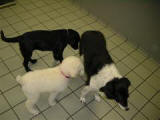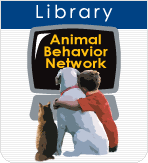|
Need Help?
|
|
Call
1-800-372-3706
to
speak to a Veterinary Behavior Technician |
|
Paws To Speak!
Member
Main Menu
|


Don't leave your dog
Home Alone!
Ask
your veterinarian about
Doggie Daycare Programs.
If
your veterinarian does
not offer daycare, check your local
PetSmart.

|
 |
|
Help is at your
fingertips by library, email and
phone. |

Click on
Library Icon
to learn more
|
Dog Obedience Classes
Should my dog be six months
old before training?
No!
The BEST investment anyone can make with a new
puppy is joining a reputable puppy socialization
class, puppy daycare, or attending a puppy
socialization while the pup is 2 to 4 months
old.
See
Puppy Off Leash Training
Most pups are ready for an adult
on leash obedience
class at about 6
months of age. Look for classes that use
positive reinforcement and not pain to teach
dogs.
Teaching your
dog a basic vocabulary gives you a means of
communication and helps your dog learn that you
control everything he/she wants in life.
If your dog sees you as the giver of everything
good, your dog will be more motivated to learn from
you and follow your instructions. However, you need to teach
your dog exactly what you want and help the dog to understand what
certain words mean. The basic vocabulary that can help the dog
learn how to act around you and your home is: come, sit, down, wait, stay, watch, shake,
back, touch, off, give, drop, leave it, etc.
Dogs will follow and try to
please a reliable, benevolent
teacher. If the dog does not
see clear rules of the home,
some dogs will try to take charge to fill this gap. Dogs
that misbehave are typically
either confused about the rules
or have the misguided notion
that their family needs them in
the leadership role.
|
Remember, dogs are a proud
member of a different
species. When we teach our
dogs basic words to follow, we are, in fact , teaching
them a foreign language. |
.jpg) Dog obedience
classes is one way to get help in teaching your dog an English
vocabulary. However, avoid all classes that use
physical force to teach canines. The best
methods are gentle and require your dog's brain
to be engaged not your brawn. Dog obedience
classes is one way to get help in teaching your dog an English
vocabulary. However, avoid all classes that use
physical force to teach canines. The best
methods are gentle and require your dog's brain
to be engaged not your brawn.
Before you
begin teaching your dog, try to learn more about how
dogs learn and communicate. It's only fair to learn
"dog language" before we expect dogs to learn "human
language".
Most animal behaviorist agree that dogs
that are labeled "bad" are simply "confused" about
what people have been trying to communicate to them.
How do I find a good class?
Avoid teachers who rely
heavily on firm collar
corrections. This is called
"compulsion" or "force training."
Although
force training may appear to
produce results and rapid
learning on the part of the dog,
there are unacceptable
disadvantages.
|
Force training damages
the bond between the person
and the dog and may create
lasting fear or defensive
aggression.
|
Why should
I look for reward-based training?
Reward-based obedience training shows the dog
EXACTLY what TO DO and what is right instead of punishing the dog for
what is wrong until the dog figures out what you
want.
Look for
classes that use food lures and treats. Food
lures show the dog exactly what words mean and produce quick and fun learning
for both of you.
Food lures
are phased out. Food rewards are used occasionally
along with praise and other reinforcers like games or toys. Would you
work very long without ever getting a paycheck.
Let's be reasonable! Always praise your
dog for good behavior. Reinforce the best responses with a variety
of rewards, including food. Keep your dog excited about learning and
pleasing you. The best rewards are life rewards. If your
dog is given instructions daily to earn
everything he/she wants, your dog will be
well-trained.
The
American Kennel
Club (www.AKC.org)
offers basic courses like the "Canine Good Citizen"
(www.akc.org/love/cgc)
and "Obedience Champion," "Search and Rescue" or
"Therapy Dog" certifications (www.tdi-dog.org).
There are many FUN classes that you can take with
your dog, including agility training, tracking,
tricks class, and flyball.
|